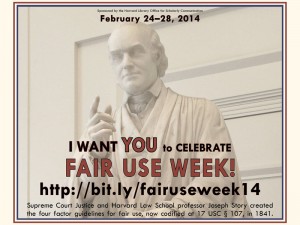Next week Fair Use Week will be observed on a number of university campus. I want to use this short post to bring some resources to my readers’ attention, make a comment on why we should all celebrate fair use week, and provide a foretaste of my contribution to the festivities, which will appear in a different forum.

In the poster above, Fair Use Week at Harvard is connected directly to the origins of this unique aspect of American copyright law, through a statue of Justice Joseph Story, who first defined what we came to call fair use in an 1841 case involving the letters of George Washington. It is fitting that that case involved a scholarly work, a life of Washington, because fair use was then and still is today one of the most important underpinnings of scholarship. We argue about its scope sometimes, but we rely on it everyday. The most basic relationship in academic writing, the quotation of a scholar in another scholar’s work, is a form of fair use that is so central and natural to scholarship that we forget what it really is and the body of law that it depends on. Fair Use Week is worthy of celebration on our campuses because it is a reminder that this aspect of copyright law is a sine qua non for scholarship and has been for a great many years.
Two institutions that I know of will be featuring fair use information and opinion in blogs, and I wanted to draw these resources to the attention of readers.
Ohio State University hosts a “Copyright Corner” blog that has been providing basic information about fair use all month long. During the next week it would be worthwhile for readers to review what has been written there.
At Harvard, a new blog called Copyright at Harvard Library will feature posts from invited guests for Fair Use Week. I hope readers will keep up with that blog, partly because one of those posts — on Tuesday, I am told — will be a contribution from me. And I thought I would offer here a quick summary of what I will say in some detail over there.
My post focuses on a case decided by the Second Circuit Court of Appeals last month. It was an odd case, involving a lawsuit brought over a surreptitious recording of a conference call made by the business news service Bloomberg. The recording was distributed to Bloomberg subscribers and the company that held the call sued, claiming copyright infringement. There are two fascinating issues in the case, I think. The first involves that fundamental requirement for a copyright, fixation in a tangible medium of expression. Since they recorded the phone call live, not from some prior fixation, Bloomberg tried to defend themselves by saying that there was no copyright in the call for them to infringe. The second issue, of course, was fair use. Both the lower court and the Second Circuit ultimately decided the issue based on fair use, and the analysis that the Appellate Court especially applied is really fascinating. In my post I try to explain how extraordinary the analysis is, and why it has potential implications for the still-pending appeal in the Georgia State University copyright case and its fair use defense.
I hope that is enough to whet your appetite and send you to the Harvard Fair Use Week blog repeatedly this week, to read my contribution and those from Kenny Crews, Krista Cox and others.

